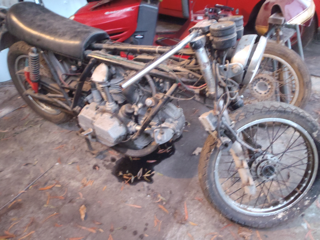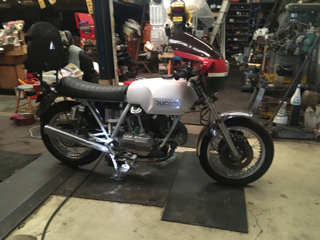by Phil Whitton
In the current parlance of the restoration fraternity, the term “barn find” is now an indication of something uncovered from the depths of some storage unit, garage or indeed a barn.
“Where did you find that?”
Over the years quite a few bikes have come to light from deceased estates, garage clearances, divorce chuckouts, whispers or just word of mouth. I’ve been on the receiving end of some machines – so the dream of finding a Mac Velo or a Rapide in a barn cleanout is still with me. It’s then a decision has to be made: whether to restore, scrap or pass on.
Such is the question I am often asked when yet another “barn find” surfaces.

I was recently offered a Ducati 900GTS – from a paddock – in a sad state. It could have found its way into a 900SS at a considerable increase in value. This now highly sought after model has since been fully restored to good, road-going condition.
To restore a machine that’s well passed its useful life can indeed be daunting. The degree of restoration required can be determined by the finished value, balanced against the cost of the rebuild. And one’s own love of the marque.
Scanning classic bike magazines provides information as to the asking value of classic bikes, as can researching bike auctions both here and in the UK/USA.
Then there’s the decision as to what level of restoration would be appropriate, whether pristine showroom, road use, cafe, chopped or just “will do”. I’m not a lover of trailer queens: bikes were built to be ridden.
Even before a spanner is put to the bike, copious photos are required as references at each part of the strip down. Best to keep each part labelled, photographed, cleaned and boxed, together with a record of the replacement parts required.
Sourcing parts, particularly for veteran or early classic machines, can be both time consuming and educational, but can be greatly enhanced by accessing marque clubs, gathering info from classic bike magazines or hitting the net. Such mags like Old Bike Australia (which lists marque clubs), Classic Motorcycle (UK), Classic Racer (UK) and British Bikes (UK), to name a few.
The change from Whitworth, AF, BSF, BSW screw threads for the British and American bikes to metric for European and Japanese bikes can result in an increase in frustration. However, there are specialist firms still producing bolts and screws, in every measure, even Chinese fine.
So while it can be admirable to attempt a full blown restoration, as Dirty Harry said, “a man must know his limitations”, it can easily go pear shaped.
In order to save a lot of heartache, farming out frames for powder coating or painting of the tinware, engine rebuilds and wheels is well worth it. Pin striping of tanks can be done with stick-ons but hand painting with daggerline brushes takes a lot of skill. Correct decal details can be sourced from original sales brochures, most of which are now on line. Most bike repainting shops have the information required so enquire before engaging their services. Be warned, it can be expensive.
Of course this is if you don’t have either the necessary skills or the equipment. Unfortunately, tech colleges no longer run those journeyman courses, where many a skill was obtained working on one’s own project.
Prior to the use of magnesium wheels, the metal rims of vintage wheels are almost always badly rusted and require complete rechroming and spoking. Spoking is easier than most think, though a photograph is essential to get the lacing correct. Trueing is a matter of tensioning as required so replacement spokes and nipples, either normal or stainless, is a must. A jig to spin the wheel on an axle with a pair of dial gauges will give the runout information. For the modern wheels magnaflux or x-raying is essential to determine the presence of fractures or corrosion.
Likewise, engine and gearbox configurations can be a black art, particularly bevel-engined Ducati and preunit gearboxes of early British machines.
Usually the old seat has become the residence of mice or rats. Most competent trimmers can do seat replacements, while replacement seats and covers for most Japanese models are readily available, even for Honda Cubs.
Electrics on early barn finds bikes invariably require new looms. Fortunately, there are now firms reproducing authentic cloth covered replacements.

The electrics of many vintage (and some modern bikes) can be reasonably simple. However, you first need to determine the polarity of the bike. Red is not always positive so checking the battery to chassis will give the correct polarity. Magnetos and points dizzy take some expert fettling but are not impossible to fix.
Keeping original paint – patina – and history can increase the value of a freshened up outfit, especially if it is a badged unit or with the ownership providence of a previous life.
Today there are a lot of rebirths and bitza bikes being presented as authentic, however the determination as to being authentic can be a minefield if chassis and engine numbers are incorrect. There are several green-framed 750 Ducatis built from crates on the market.…….
Replaced frames or engines are common with British bikes of the ‘60s, together with the common practice of cafe builds using what was available, such as Norvins, TriTons, Egli Vincents and the like. What came out of Armory Rd or Merriden at the end of the ‘60s was “original” from the production line in order to keep sales going.
Swapping components from Lucas fitted a wide range of machines so commonality of parts can be a blessing. A Norton points plate fits the A65 BSA range and the headlight switch is common. My Lucas key #995 fired several club bikes (and even the Jaguar Sovereign).
There is a library of information from such knowledgeable sources like Roy Bacon, Hopwood, Faloon and others specialising in the marque.
There are authors who specialise in one marque and are well worth seeking out as either a source of information or when undertaking a specific part of the restoration.
In the end, it can be very satisfying when viewing your resto at a show ‘n shine or club ride. We are just the custodians of these machines: “I’m just investing in my hobby, darling”.
Well that’s my story………

